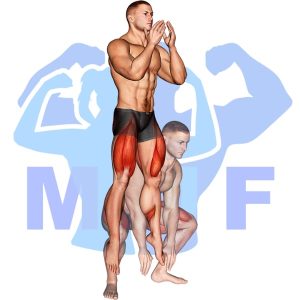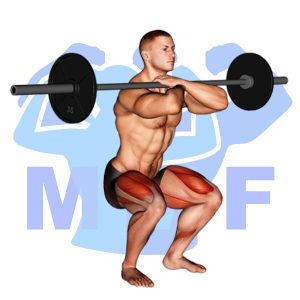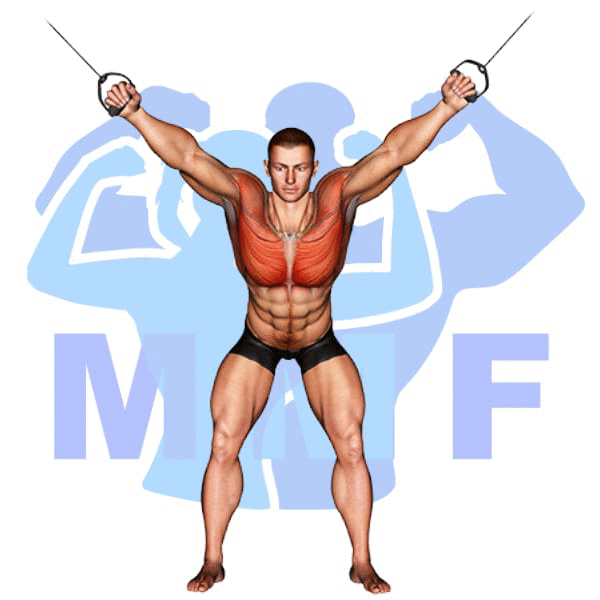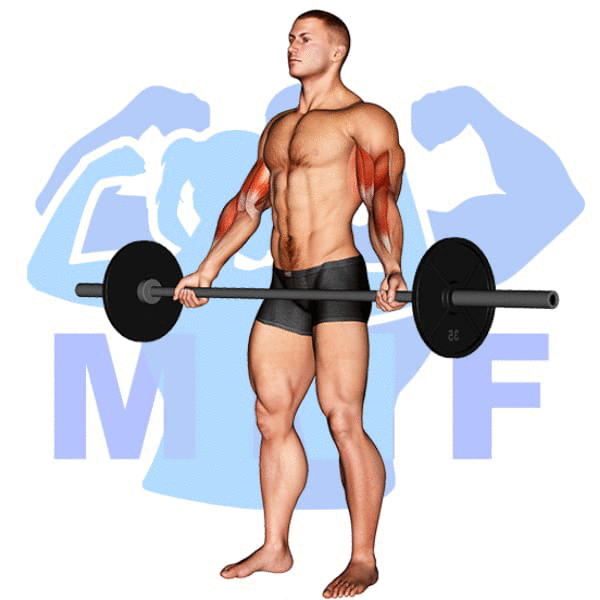Have you ever struggled with performing a squat without compromising your form? Do you often dread heading to the squat rack because of the fear of injury? If you can relate to these issues, you’re not alone. Squats are one of the most challenging and beneficial exercises for your lower body, but improper execution can lead to discomfort or injury. One solution to this problem is the Smith Squat – a variation of the classic exercise that offers extra support and stability. In this blog post, we will explore the benefits of the Smith Squat and show you how to perform it correctly to take your lower body workout game to the next level.
Smith Machine Squat Summary
- Primary Muscles: Quadriceps
- Secondary Muscles: Adductor Magnus, Gluteus Maximus, and Soleus
- Equipment: Smith Machine
- Mechanics Type: Compound
- Force: Push
- Utility: Basic

Smith Machine Squat Instructions
- Set the barbell on the Smith Machine at shoulder height.
- Adjust the safety catches so they are slightly above your head.
- Step under the barbell and position it on your upper back just below your neck.
- Place your hands on the barbell and unrack it.
- With your feet shoulder-width apart, toes slightly pointing outwards, sit back and down.
- Descend until your thighs are parallel to the floor or slightly lower.
- Push through your heels to return to the standing position.
- Re-rack the barbell in the Smith Machine.
Video Tutorial
Smith Machine Squat Muscles
Target (Agonist)
Synergists
- Adductor Magnus
- Gluteus Maximus
- Soleus
Dynamic Stabilizers
Stabilizers
- Erector Spinae
- Levator Scapulae
- Trapezius – Middle
- Trapezius – Upper
Antagonist Stabilizers

Benefits of Smith Machine Squat
The Smith Machine Squat is an effective exercise for strength training and fitness routines, as it works the major muscle group of the quadriceps. The specific benefits of performing this exercise include increased strength, improved balance and coordination, and improved flexibility. Furthermore, the Smith Machine Squat has been found to help reduce the risk of injury, as it allows the user to control their range of motion and the amount of weight used. With regular practice, the Smith Machine Squat can help build powerful and strong legs.
Tips for Performing Smith Machine Squat
When using the Smith Machine Squat, it is important to keep in mind that proper form and technique are key in order to maximize the benefits of the exercise. To help you achieve the best results, here are some tips to keep in mind while performing the Smith Machine Squat.
- Ensure proper form and technique: It is important to keep a wide stance, with your feet slightly wider than shoulder-width apart and toes pointed out slightly. Keep your back straight and chest up throughout the entire exercise, and ensure that you are squatting all the way down, so that your thighs are parallel with the ground.
- Engage your core muscles: Engaging your core muscles throughout the entire exercise will help keep your body in proper alignment and will help to protect your spine from injury.
- Go slow and controlled: Make sure you are taking your time and focusing on the movement and proper form, rather than rushing through the exercise. Going slow and controlled will help you get the most out of the exercise and will help to prevent injury.
Benefits and Tips Video
Frequent Mistakes To Avoid
When performing a Smith Machine Squat, it is important to remember that there are several potential mistakes that can be made. These mistakes could potentially lead to injury or decreased performance, so it is important to be aware of them and strive to avoid them. By avoiding these mistakes and focusing on correct form, you can maximize your results and minimize the risk of injury.
- Not using proper form: When performing the Smith Machine Squat, it is important to keep your back straight, chest up, and feet slightly wider than shoulder-width apart. If you don’t maintain proper form, it can put unnecessary strain on your lower back and increase the risk of injury.
- Not controlling the weight: It is important to control the weight throughout the entire movement and avoid bouncing the weight at the bottom of the movement. This can put too much stress on the joints and increase your risk of injury.
- Not activating your core: Make sure you are activating your core throughout the entire movement. This will help stabilize your body and ensure you are using the proper muscles during the exercise.
Find More Machine Exercises Here
Variations and Complementary Exercises
In addition to the Smith Machine Squat, there are several variations, complementary, and alternative exercises that can be done to work similar muscles. These exercises are listed below and can be incorporated into your workout routine for added variety.
Smith Machine Zercher Squat

The Smith Machine Zercher Squat is a great alternative or complementary exercise to the Smith Machine Squat. This exercise involves the athlete holding the weight in front of them in a low position and squatting down. This variation of the Smith Machine Squat puts more emphasis on the core, hips, and glutes than the traditional Smith Machine Squat. Additionally, this exercise also works out the muscles of the upper back and arms. This exercise can help to develop strength and stability in the entire lower body, while also providing a great challenge for those who want to go beyond the traditional Smith Machine Squat.
Squat Jump

The squat jump is a great complementary or alternative exercise to the Smith Machine Squat. It is an explosive, plyometric exercise that builds explosive power and strength in the legs and glutes. The squat jump involves jumping from a squat position with arms extended overhead, then landing back in the squat position. This exercise helps develop explosive power and strength, which can help improve performance in activities such as running and jumping. It is also a great way to improve balance and coordination, as well as increase your overall fitness level. The squat jump can be done with or without weights to increase the challenge and intensity of the exercise.
Squats With Bands

Squats With Bands is an excellent alternative or complementary exercise to the Smith Machine Squat. It provides a greater range of motion and engages more muscle groups than the Smith Machine Squat. The bands provide additional resistance, which helps increase strength and power. Additionally, Squats With Bands also focuses on proper form, balance, and stability, as well as improving core strength. This exercise is also a great way to improve mobility, flexibility, and coordination. Therefore, Squats With Bands can be used as a great alternative or complementary exercise to the Smith Machine Squat.
Check Out These Top Machine Exercises
Barbell Front Squat Clean Grip

The Barbell Front Squat Clean Grip is an effective alternative or complementary exercise to the Smith Machine Squat. It involves holding a barbell in front of your body with an overhand grip and squatting down to parallel. This variation of the squat works your core, glutes, and quads more than the Smith Machine Squat, and requires more stability from the lifter. This exercise is great for athletes looking to increase strength and explosiveness, as it works the same muscle groups as the Smith Machine Squat but with a different emphasis.
Barbell Front Squat Cross Arm Grip

The Barbell Front Squat Cross Arm Grip is an excellent alternative or complementary exercise to the Smith Machine Squat. This exercise works the same muscles as the Smith Machine Squat, but the barbell is held in front of your body instead of on your back. This variation emphasizes the quads, glutes, and hamstrings, while also engaging your core muscles to help stabilize the barbell. Additionally, since you’re using a barbell instead of a Smith Machine, you’ll get a greater range of motion and recruit more muscles.
Barbell Front Sumo Squat

The Barbell Front Sumo Squat is a great alternative or complementary exercise to the Smith Machine Squat. This exercise is performed by standing with feet slightly wider than shoulder-width apart, toes slightly pointed outwards, and a barbell across the front of the shoulders. From this starting position, the hips are lowered until the thighs are parallel to the ground, and then returned to a standing position. This exercise is beneficial because it increases overall hip mobility, while still providing the same core benefits of a squat. Additionally, the wider stance of the sumo squat allows for a greater range of motion in the hips, which can help to improve overall strength and power.
Find More Legs Exercises Here
Opposing Complementary Exercises
In addition to Smith Machine Squat, there are several other exercises that can be used to complement this exercise and work the opposing muscle groups. These exercises will help to build strength and balance throughout the entire body, allowing for an overall better workout. Below are a few exercises to consider when incorporating into your workout routine.
Barbell Deadlift

The Barbell Deadlift is a great complementary exercise to the Smith Machine Squat as it works the opposing muscle groups. The deadlift strengthens the posterior chain of muscles, including the glutes, hamstrings, and lower back, while the Smith Machine Squat focuses on the quads and core. Together these exercises provide a comprehensive lower body workout that will help to build strength and power. By targeting different muscle groups, these two exercises can be used together to create a balanced and effective workout routine.
Band Stiff Leg Deadlift

The Band Stiff Leg Deadlift is a great exercise to pair with the Smith Machine Squat. This exercise is complementary because it works the opposing muscle group in the lower body. The Band Stiff Leg Deadlift works the hamstrings, glutes, and lower back muscles, while the Smith Machine Squat works the quads and hip flexors. By working both the front and back of the legs, this pairing strengthens and balances the lower body. Additionally, by using resistance bands, you can increase the intensity of the exercise and add an extra challenge to your workout.
Barbell Snatch Deadlift

The barbell snatch deadlift is a great complement to the Smith machine squat because it targets the opposing muscle group. It works the posterior chain, which includes the glutes, hamstrings and lower back muscles. This exercise is particularly beneficial for athletes and weightlifters who need to develop strength and power in their posterior chain. By incorporating the snatch deadlift into a workout routine, you can effectively strengthen and balance out your overall lower body strength. In addition, the barbell snatch deadlift helps increase flexibility in your hips, which can improve your squat form and overall performance.
Squat To A Stronger You With The Smith Squat
If you are looking to add strength to your lower body, the Smith Squat is a great option to consider. The Smith Squat is similar to a traditional squat, but it allows for added stability and control. By using the machine, you can focus on your form and technique while working on building your muscles. As with any exercise, it is important to start with lighter weight and gradually increase as you become more confident in your abilities. Incorporating the Smith Squat into your fitness routine can help you see results and achieve your goals.
References: Wikipedia | ExRx.net | PubMed.gov | Comprehensive List of Legs Machine Exercises




